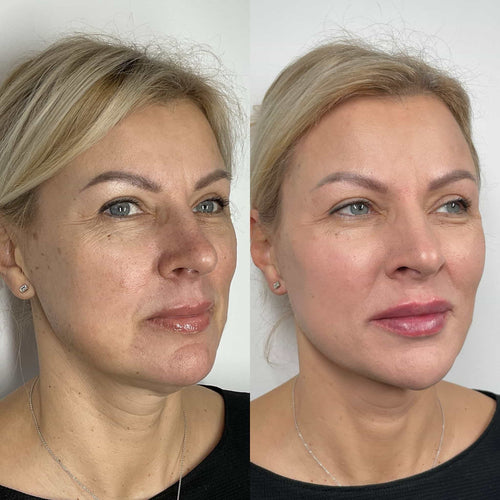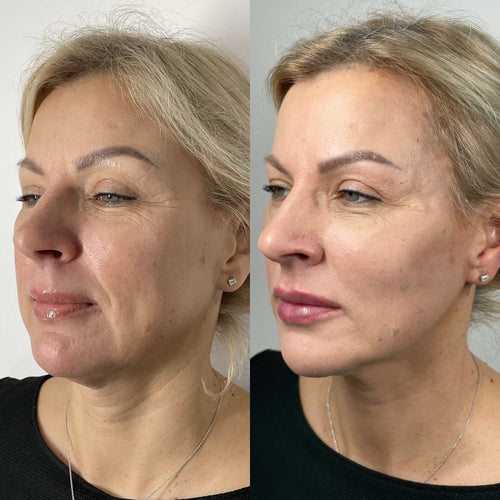What Does 1ml Of Cheek Filler Look Like?
Consult with Dr. Laura Geige for Dermal Fillers at It’s Me and You Clinic
Expected Outcomes
Volume Enhancement
Volume enhancement with dermal fillers, such as those injected into cheeks, aims to restore lost volume and enhance facial contours.
A common question is, “What does 1 ml of cheek filler look like?”. This depends on several factors, including the individual’s pre-existing facial structure, desired outcome, and the specific type of filler used.
Expected Outcomes:
In general, 1 ml of cheek filler can subtly elevate and round the cheeks, creating a more youthful and sculpted appearance. It can also help define the cheekbones, minimize hollows or indentations, and improve facial symmetry.

The results are often described as natural-looking and gradual. A well-placed injection can enhance your existing features rather than drastically changing your overall look.
Factors Affecting Results:
Individual anatomy plays a significant role in how 1 ml of filler will appear.
Some people have naturally higher cheekbones or more defined cheek structures, while others may have more prominent hollows.
The desired outcome also influences the placement and amount of filler used. For example, someone seeking subtle enhancement might opt for a smaller volume, while someone desiring a more dramatic transformation might require multiple syringes.
The type of filler chosen also impacts the results.
Different fillers have varying consistencies and lifting capabilities. Some are designed for volumization, while others are better suited for contouring.

Communication is Key:**
It’s crucial to communicate your desired outcome and any concerns with a qualified and experienced injector. They will assess your facial features, skin type, and medical history to determine the appropriate filler volume, placement, and technique for achieving your goals.
Contour Definition
Expected outcomes when using 1 ml of cheek filler vary greatly depending on individual facial anatomy, desired results, and the type of filler used.
Contour definition refers to the sculpting and shaping of the face through the strategic placement of dermal fillers.
With 1 ml of cheek filler, a noticeable enhancement in cheek volume and projection can be achieved. This typically involves lifting the cheeks, creating more pronounced cheekbones, and adding fullness to the midface.
The degree of contouring depends on factors like the patient’s starting point, desired outcome (subtle vs. dramatic), and the skill of the injector.
1 ml might create a subtle lift for someone with already prominent cheeks but add significant definition to someone with less volume.
It’s important to remember that results are not immediately apparent. Swelling typically occurs after injection, which gradually subsides over several days.
The final outcome becomes visible as the swelling diminishes, revealing the sculpted and enhanced cheek structure.
Facial Harmony
Expected outcomes from cheek filler depend on individual facial anatomy, desired results, and the expertise of the injector.
Here’s a breakdown of potential changes with 1ml of cheek filler:
-
Subtle volume enhancement: This amount can subtly lift the cheeks, creating a more youthful appearance by restoring lost volume.
-
Contour definition: Filler can enhance cheekbones, adding definition and a more sculpted look.
-
Cheek asymmetry correction: A small amount of filler can help balance minor asymmetries in the cheeks.
Facial harmony is crucial when considering any cosmetic enhancement.
Cheek fillers should be used to complement existing facial features, not create an overly unnatural look.
A skilled injector will consider factors such as:
-
Facial proportions: The balance between cheekbones, jawline, and forehead is essential for a harmonious look.
-
Skin type and thickness: Filler placement may vary depending on whether someone has thin or thick skin.
-
Individual preferences: It’s important to discuss desired outcomes with the injector to ensure they align with personal goals.
Remember that achieving natural-looking results often requires a subtle approach.
Excessive filler can lead to an unnatural or overfilled appearance.
Factors Influencing Appearance
Individual Anatomy
Many factors contribute to an individual’s facial appearance, with individual anatomy playing a significant role.
Here are some key factors that influence how cheek filler might appear in one person versus another:
Get Started with Dermal Fillers – Book with Dr. Laura Geige
- Bone Structure: The underlying structure of the face, including the zygomatic bones (cheekbones), determines the natural contours and prominence of the cheeks. Individuals with naturally high cheekbones may require less filler to achieve desired results compared to those with lower cheekbones.
- Fat Distribution: Facial fat pads are responsible for providing volume and fullness to the cheeks. As we age, these fat pads can atrophy, leading to a loss of volume in the cheek area. The distribution of facial fat varies significantly among individuals, influencing how filler placement affects overall facial appearance.
- Skin Thickness and Elasticity: Thicker skin generally absorbs more filler, potentially requiring larger volumes to achieve noticeable results. Skin elasticity also plays a role; less elastic skin may show the effects of filler more prominently.
- Muscle Anatomy: The position and strength of facial muscles, such as the masseter (jaw muscle) and zygomaticus major (smiling muscle), can influence cheek volume and contours.
- Filler Type and Technique: Different types of dermal fillers have varying properties in terms of consistency, longevity, and lift. The skill and experience of the injector also significantly affect the placement and outcome of cheek filler.
It’s important to remember that individual responses to cheek filler can vary widely due to these unique anatomical factors. Consulting with a qualified and experienced aesthetic practitioner is crucial for determining the appropriate amount and type of filler, as well as realistic expectations for results.
Injection Technique
Determining the exact visual outcome of injecting 1 ml of cheek filler is complex and depends on several interconnected factors.
One primary factor is the individual’s starting point—their natural facial anatomy. Cheekbone structure, fat distribution, skin elasticity, and muscle mass all play a role in how the filler will integrate and appear. Someone with naturally hollow cheeks may see a more dramatic difference than someone with already prominent cheeks.
The type of hyaluronic acid filler used also significantly influences results. Different brands and formulations have varying densities (thicknesses) and viscosities, affecting how they lift and sculpt the cheek area. A thicker filler might create a more volumized effect, while a lighter one might be better for subtle enhancement.
Injection technique is paramount. A skilled injector will consider facial symmetry, balance, and individual aesthetic goals to determine the precise placement of the filler. Overfilling can lead to unnatural-looking results, while underfilling might not provide sufficient lift or contouring.
Other factors include the patient’s desired outcome. Some seek subtle volume enhancement, while others may want a more dramatic transformation. This influence dictates the injector’s approach and filler choice.
Skin quality also plays a role. Thinner skin might make the results of filler more pronounced, potentially leading to visibility of injection points or “bumps.” Conversely, thicker skin may require more product for noticeable enhancement.
Finally, individual healing responses vary. Swelling is a common side effect after cheek filler injections, and it can take several days to weeks for the final result to become apparent. This variability makes it challenging to predict with absolute certainty what 1 ml of filler will look like on any given individual.
Filler Type
Many factors influence how 1ml of cheek filler will appear. The most crucial factor is individual anatomy. Everyone’s facial structure, bone shape, fat distribution, and skin thickness are unique.
Think of it like sculpting with clay. If you have naturally high cheekbones, 1ml might accentuate them subtly, creating a more defined contour. Someone with flatter cheeks might see a more noticeable lift and roundness.
Dermal filler type also plays a significant role. Different fillers have varying densities and compositions.
Hyaluronic acid (HA) fillers are common due to their natural presence in the body, making them biocompatible and reversible with an enzyme called hyaluronidase. HA fillers can range from light and volumizing to more firm and cohesive, influencing how they lift and shape the cheeks.
Poly-L-lactic acid (PLLA) fillers gradually stimulate collagen production, offering longer-lasting results. These might create a more subtle enhancement over time, as opposed to an immediate dramatic change.
Calcium hydroxylapatite (CaHA) is another option known for its structural support. It can be used to define cheekbones and provide a more contoured appearance.
Other factors to consider include the skill of the injector. A skilled injector will assess your anatomy, understand the desired outcome, and strategically place the filler for natural-looking results.
Additionally, individual healing responses vary, and swelling after injection can temporarily affect the appearance. It’s important to follow post-procedure instructions carefully to minimize any side effects and allow for optimal settling of the filler.
Realistic Expectations and Aftercare
Subtle vs. Dramatic Results
Understanding *realistic expectations* is crucial when considering any cosmetic procedure, especially facial fillers like cheek augmentation with 1 ml of product.
A common misconception is that injectables will drastically alter your appearance. Remember, subtle enhancements are often the most natural-looking and long-lasting.
Aftercare plays a vital role in achieving optimal results and minimizing risks.
- **Avoid strenuous activity** for at least 24 hours following treatment.
- Apply *ice packs* intermittently to reduce swelling.
- Sleep with your head elevated.
- Refrain from touching or massaging the treated area.
- Follow your injector’s specific post-treatment instructions carefully.
*Subtle* results are generally achieved when using 1 ml of cheek filler. This volume is sufficient to subtly enhance the cheekbones, adding definition and creating a more sculpted look.
For those seeking a *dramatic* transformation, larger volumes of filler might be required, but it’s important to consult with your injector to determine what is appropriate for your facial structure and desired outcome.
Consider the following factors when deciding on your level of desired enhancement:
- Facial Anatomy:**
- Desired Outcome:**
- Prior Filler Experience:**
Are you aiming for a natural lift, a more contoured look, or a more dramatic change?
If you’ve had fillers before, your injector might be able to use previous results as a guide.
Open and honest communication with your injector is essential. Discuss your goals, concerns, and *realistic expectations*. They can assess your suitability for treatment and provide personalized recommendations.
Recovery Timeline
Understanding realistic expectations and proper aftercare are crucial for a successful and satisfying experience with dermal fillers like cheek augmentation.
Realistic Expectations:
- Subtle Enhancement: 1 ml of cheek filler typically provides a subtle lift and contouring. It’s not designed to dramatically alter facial features but rather enhance existing contours for a more youthful and balanced appearance.
- Individual Results Vary: Facial anatomy, skin thickness, and the product used influence the final outcome. Results may vary from person to person.
- Gradual Integration: It takes time for fillers to settle fully into the tissue. Initial swelling will subside within a few days, revealing the more natural-looking result over the following weeks.
Aftercare:
- Avoid Pressure and Touching: Minimize touching or pressing on the treated area for at least 24 hours to prevent bruising and displacement of the filler.
- Ice Packs: Use ice packs for 10-15 minutes at a time, several times daily, during the initial 24-48 hours to reduce swelling.
- Sleeping Position: Sleep with your head slightly elevated to minimize swelling and promote proper drainage.
- Hydration:** Drink plenty of water to keep skin hydrated and support healing.
Recovery Timeline:
- Initial 24-48 Hours: Expect some bruising, swelling, and tenderness. Follow aftercare instructions diligently.
- Days 3-7: Swelling significantly decreases, and the treated area starts to feel more normal. Makeup can be applied cautiously.
- Week 1-2:** Most bruising disappears, and the filler settles into its final position.
- Long-Term:** Results typically last 6-18 months, depending on individual factors and product type.
A Glossy Life Blog Apples and Pears Co. C4YL My Better Love Audrey’s JL
- Why Ghosting Is A Harmful Dating Trend - November 3, 2025
- What Is The Drink With THC In It? - November 2, 2025
- What Are The Best CBD Infused Gummies For Relaxation - October 31, 2025

